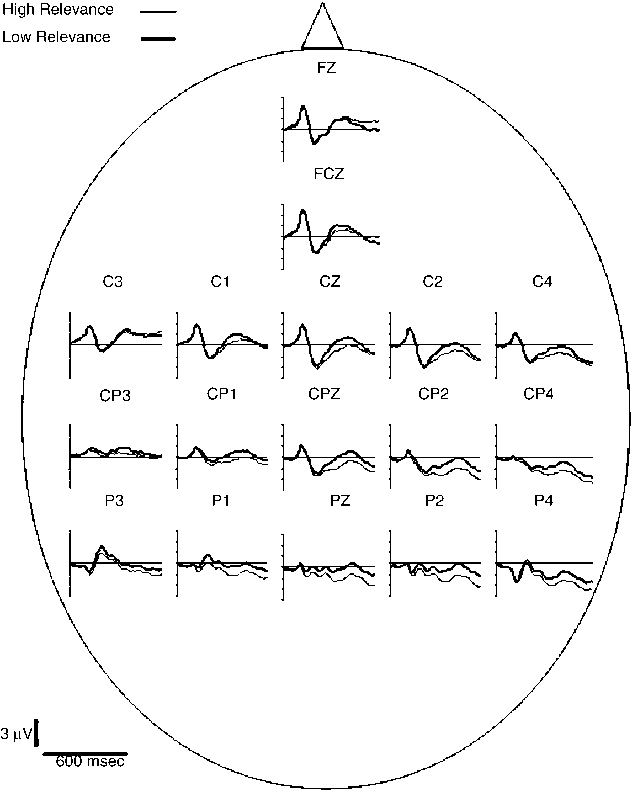G. Sartori et al. /Neuroscience Letters 390 (2005) 139-144
143
incongruent high relevance descriptions as compared with
congruent high relevance descriptions. There was no dif-
ference between congruent and incongruent low relevance
descriptions. Finally, the interactions between Category and
Relevance (F(1,23) = 0.30; p = 0.59) and between Feature
Type and Relevance (F(1,23) = 2.11; p = 0.16) were not sig-
nificant.
A similar analysis was conducted using Category (Liv-
ing versus Non-living), Relevance (High versus Low), Fea-
ture Type (Sensory versus Non-sensory), Congruency (Yes
versus No) and Laterality (CP3, CP1, CPZ, CP2, CP4)
as within-subjects factors. The absence of any Category
effect (F(1,23) = 1.79; p = 0.194), a strong Relevance effect
(F(1,23) = 33.16; p < 0.001) and also a strong Congruency
effect (F(1,23) = 28.34; p < 0.001) were confirmed. Further-
more the significant interaction between Congruency and
Laterality (F(4,92) = 4.79; p < 0.001) indexes a larger N400
on the right hemisphere sites, a result that was reported before
many times [13].
The N400 amplitude to Sensory descriptions did not dif-
fer from that of Non-sensory descriptions (F(1,23) = 0.47;
p = 0.51). This result clearly indicates that when semantic
relevance is matched among feature types any previously
reported difference in ERPs disappears [3].
Previous electrophysiological investigations using the
N400 indicated both a Category effect with larger N400 for
Living (as compared to Non-living [8,11,23]) and a feature
type effect with larger N400 for Sensory semantic features (as
compared to Non-sensory [3]). This pattern of results leaded
to contrasting interpretations. On one side, different ERPs
between categories seemed to parallel behavioural dissocia-
tions between Living and Non-living. This was interpreted as
supporting the view that categories were organising princi-
ples at neural level [2]. On the other side, the different ERPs
between feature types (Sensory versus Non-sensory) was also
considered as evidence for an organising principle based on
featural content (e.g. [14]) (Figs. 1-3).
Our data show that these may be spurious results due to
the lack of control over a parameter of semantic features that
greatly affects concept retrieval: semantic relevance. In fact,
given that lower semantic relevance is characteristic of Living
and of Sensory features [19], and given that lower relevance

Fig. 3. ERPs to High Relevance as compared to Low Relevance concept descriptions. Negativity is larger to Low Relevance descriptions.
More intriguing information
1. Cancer-related electronic support groups as navigation-aids: Overcoming geographic barriers2. Mergers under endogenous minimum quality standard: a note
3. Palkkaneuvottelut ja työmarkkinat Pohjoismaissa ja Euroopassa
4. The name is absent
5. Subduing High Inflation in Romania. How to Better Monetary and Exchange Rate Mechanisms?
6. Gerontocracy in Motion? – European Cross-Country Evidence on the Labor Market Consequences of Population Ageing
7. The name is absent
8. El Mercosur y la integración económica global
9. Automatic Dream Sentiment Analysis
10. Forecasting Financial Crises and Contagion in Asia using Dynamic Factor Analysis